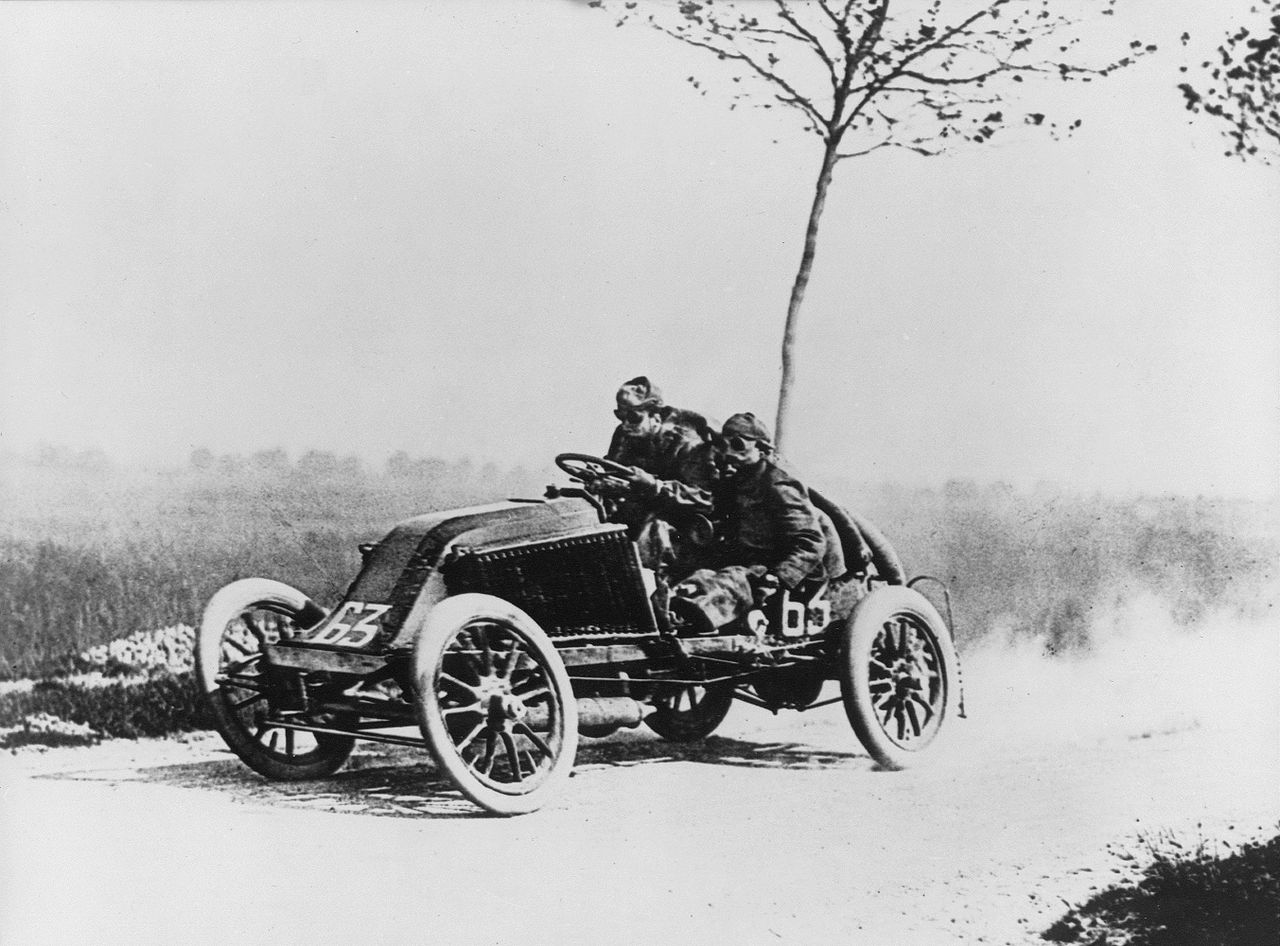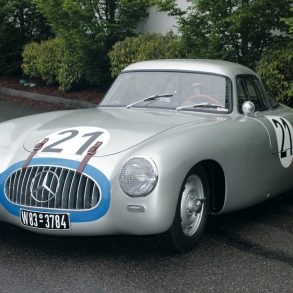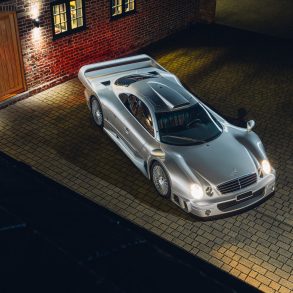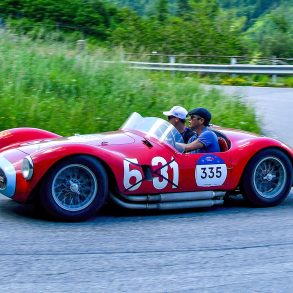Motor Racing History – Origins of the First Automobile Races and the First Grand Prix
Dawn of Automobile Racing
The dawn of automobile racing was anything but that. It was thought that a car’s ability to navigate roads in a reliable manner was all that could be hoped for. Outright speed was not even considered important that is until the flag dropped …
The first event to have been planned was to have been a short trial in Paris organized by “Le Velocipede” in 1887, but only one competitor turned up and so it was abandoned. The first organized event was actually a Reliability Trial run from Paris to Rouen in 1894 over a distance of 126 km. It was organized by a newspaper, Le Petite Journal, and the winning “horseless carriage” had to be “safe, easily controllable and reasonably economical to run.” Twenty one entries left Paris on July 22nd, and the first home was Count de Dion in a steam driven De Dion tractor.
Unfortunately for De Dion, the jury decided that his car was not a practical road vehicle and instead awarded the prize jointly to the next two leading cars, a Peugeot and a Panhard-Levassor respectively. The winning average speed was an exhilarating 17km/h. Many town races were run in the following years including Paris to Bordeaux and back. This 1895 event, a true race, was won by Emille Levassor. Driving a 2-cylinder, 4-bhp Panhard-Levassor he drove 48 hours 48 minutes virtually non-stop. Because his car only had two seats instead of the required 4 he was denied the prize of 31,000 francs, yet it is his statue that overlooks the finishing line at the Porte Maillot in Paris. Another interesting entrant in this race was the Peugeot of André Michelin which used pneumatic tires. Typically wheels used on other cars were either iron or solid rubber. At first the “air tyre” was ridiculed as impractical and indeed Michelin’s car suffered from numerous flats due to the poor condition of the roads at the turn of the century. Panhard along with Mors would dominate racing until the end of the century.
The first Italian race took place on the 18th of May, 1895. The 93 kilometer route took the drivers from Turin to Asti and back. Only five competitors took the start and of those three were able to finish. The winner was Simone Federmann at an average of 15.5 kph in a Daimler Omnibus which contrary to its name had a seating capacity of four. 1895 marked the formation of the Automobile Club de France while in America the Chicago Times Herald sponsored a race or more accurately a challenge as there were only two competitors. The A.C.F. sponsored what would be the longest race held up to that time from Bordeaux to Agen and back to Bordeaux, a distance of `1710 kilometers. Rather than one long race the event was divided into 10 stages and rand from September 24th to October 3rd. To the delight of the French crowd the first two places were won by Panhards followed by a De Dion-Bouton tricycle in third.
The following years saw an ever increasing search for speed and the easiest path was to increase engine size. Soon 7 and 8 liter engines were common place and even a 16 liter engine was produced. Developments in chassis design, brakes and tires did not maintain pace but in 1901 that changed with the introduction of the 35 h.p. Mercedes. It was the first sports-racing car which featured a fur-cylinder engine with mechanical valves, a “honeycomb” radiator, a steel chassis, pneumatic tires and a magneto ignition. After solving some early reliability problems and coupled with the increase of engine capacity to 9 liters producing 60 h.p., the car became a consistent race winner. Each of the leading manufactures contributed advancements to automobile design. Renault produced a car with shaft drive and a live rear axle.
The Gordon Bennett Races
James Gordon Bennett arrived in Paris in 1887 and had established a Continental edition of his father’s New York daily. This being the same Bennett that sent Stanley in search of Livingstone had an eye for publicity. In July 1899 he established a series of races bearing his name. The six international motor races held between 1900 and 1905 came to be known as the Gordon Bennett Cup Race but within the pages of the New York Herald and its Paris offshoot it was always referred to as the Coupe International. Gordon Bennett himself never drove an motor car and in fact never witnessed any of his races.

Two side-by-side seats occupied at all times with driver and mechanic weighing no less than 60 kg. apiece and a minimum empty weight of 400 kg for the vehicle. Any means or propulsion was allowed. Each nation would be allowed to select a team of three cars with the drivers being members of the respective club and the cars themselves had to be made in their entirety in the country whose colors they wore. It was these last rules that would cause contention. The initial race would run from Paris to Lyons. The race was won by Fernand Charron driving a Panhard-Levassor at an average speed of 38.6 mph. He was followed by another Frenchmen, Léonce Girardot, also on a Panhard who was the only other driver to finish out of the original five drivers that had entered the race.
For 1901 the Gordon Bennett Cup race was to be run concurrently with the ‘open’ Paris-Bordeaux race. In deference to the Cup’s international status, their entrants would be dispatched before the open entrants. Napier had planned to contest the Cup on behalf of England but due to the use of French manufactured tires was relegated to the concurrent open race. The Cup turned into an all French affair. In the end the sole survivor in the cup race was Giradot but he was eclipsed by the open Mors of Henri Fournier at an average speed of 53 m.p.h. 1902 saw the first British entrants in the Cup and one a Napier driven by S.F. Edge scored an unexpected victory. The British victory in the Cup race proved a turning point for the series as the French had finally been beaten and could never take the race so lightly again.
On a cool and cloudy day, July 2, 1903, starting at seven minute intervals Camille Jenatzy drove the race of his life on a track riddled with curves and bumps. At the wheel of a car that was inferior in terms of horse power he tailored his spectacular driving style accelerating out of curves. A fellow participant marveled: “Throughout the seemingly endless series of curves, Jenatzy kept his foot to the floor. He skidded at breakneck speed around the corners, often only narrowly missing the bordering walls in the process, as was shown by his skid marks that were everywhere to be seen. I could not imagine that he could keep up this daredevil driving style for very long.” By the time the race was over the Gordon Bennett Cup was headed back to Germany. Jenatzy for his efforts was awarded a prize of £8,000.

The 1904 Gordon Bennett’s cup was held in Germany’s Taunus Forest at the suggestion of Kaiser William II and drew entries from eight countries. At the time it was considered the single most important race in the world. The course stretched over 550 km in the pine forest, consisting of four laps that started from the ancient Roman bastion of Saalburg heading north to Usingen, where there was a control point (an inhabited or built up area where the cars had to travel slowly under the supervision of course officials).
Other control points were established at Grävenwiesbach to Weilburg, then past Allendorf and Obertiefenbach to Limburg. The last section was reported to be the best part of the course for high speed and in practice some cars traveled at 150 km/h. After Limburg the course ran through Kirberg to Neuhof, Idstein then ran through Glashütten to Königstein,via Friedrichshof and Oberursel to Homburg and back to Saalburg where they arrayed spectacular grandstands fit for a Kaiser. Leon Théry won the at an average speed of 54.5 mph. With each of his laps within 3 minutes of the other he had earned his nickname of the “Chronometer”. Bennett Cup would continue for another year before it to was gone.
Grand Prix
The A.C.F. decided after many disagreements with the organizers over regulations limiting the entrants from any one country to hold their own races. In 1906 The French held the very first Grand Prix for manufactures over a 64-mile triangular course 130 miles west of Paris near the quiet town of Le Mans with the Bollee automobile factory close by. Route 23 – the Paris road – was the scene of the start. Each leg of the course was approximately 20 miles in length with sharp corners at La Ferte Bernard, St Calais and St Mars-le-Briere. In a couple of places short sections of wooden track connected the roads. Forty miles of barricades were constructed to control the spectators with a tunnel under the race track to allow safe passage.
The race had 32 starters from 12 manufacturers, three cars each from Brasier, Clement-Bayard, Darracq, FIAT, Hotchkiss, Lorraine-Dietrich, Itala, Mercedes, Panhard and Renault, with single-car entries from Gobron-Brillié and Gregorie. Each team had a number with a letter identifying the individual cars. The red painted Renault cars had the codes 3A, 3B and 3C to be driven by Szisz, Edmond and Richez. The first car started at 6 AM and was followed in 90 seconds intervals. The day turned out to be extremely hot with temperatures over 40 degrees Celsius. Of the cars that started the race 11 remained after 12 laps split over two days. The winner was Ferenc Szisz, a Hungarian, driving a 90hp Renault. His Renault utilized detachable rims created by Michelin which enabled him to change tires in 2 to 3 minutes instead of the normal 15 minutes. Another important event that year was the inaugural Targa Florio. Organized by the wealthy Sicilian Vincenzo Floria, the race covered three laps of 148.832 km over mountain roads unchanged since the Punic Wars.
In 1907 the Germans held their own race, the Kaiserpreis, for touring cars of under 8 liters and weighing less than 1165 kg. The race was won by Nazzaro in a Fiat. France, the birthplace of auto racing was finding itself among the also-rans. After dominating racing up until 1906 they were supplanted by the Alfa of Italy and Mercedes of Germany. Still the race that mattered the most was the Grand Prix and in 1908 the organizers set a weight minimum of 1100 kg and limited the bore to 155 mm. At the time it was believed that the bore was the determining fact in engine performance.
Daimler redesigned the massive four cylinder engine of the 1907 car with a bore of 154.7 mm and a stroke of 170 mm, giving a displacement of 12.8 litre. The engine was cast in pairs and featured overhead intake valves and side exhaust valves. Each set of valves was actuated by a lateral camshaft fitted in the crankcase. The approximately 130 bhp was transferred to the rear wheels through a separate four speed gearbox and by massive chains. The drivetrain was installed in straightforward pressed steel ladder frame, which was suspended all-round by live axles and semi-elliptic leaf springs. Fitted with very minimal bodywork, the completed car weighed in just over 1100 kg minimum.
With the company’s and country’s honor at stake, Mercedes left little to chance. The new cars were seen testing at the Dieppe track three months before the Grand Prix. On race day three meticulously prepared examples of the ‘140 hp’ were lined up. The pit crew was also well prepared to handle the many tire/wheel changes expected due to the poor track surface. The cars were fitted with revolutionary one-bolt wheels and the pit crew had pneumatic jacks to further speed up the work. The total number of cars entered was an unprecedented 48 and half of them were French.
In the race Salzer took off to a flying start by recording the fastest lap on the opening one. He retired shortly after with mechanical problems. After almost seven hours and eleven tire changes Lautenschlager, the factory’s official test driver in his very first race came through to take Mercedes’ first Grand Prix.
Racing Peugeots of 1912-1919 were considered by many the forefather of modern racing cars. The first car was built in 1911 and the results were not long in coming with Boillot winning the 1912 Grand Prix of France followed by victories at the Coupe de la Sarthe and the Indianapolis 500 the following year. The team persevered with a 3-litre voiturette as well as a 5.6 litre Grand Prix car winning numerous races and making 1913 their most successful year.
Many consider the 3-litre car Peugeot’s masterpiece that was producing for that time an astonishing 30 bhp/litre. Ironically Peugeot management made it a policy to sell the GP cars as soon as they had run a race or two and a buyer had come forward. The market for these world beating cars were as you can imagine quite vast and soon copies of Grand Prix Peugeots could be seen on both sides of the Atlantic. Sunbeam of England went so far as to taking apart and copying every piece of their recently purchased example only to put it together again and loan it to other British engineers, somewhat akin to what transpired when the Mercedes and Auto Union Silver Arrows cars fell into Allied hands after World War II. Victories continued in 1914 leading up that years Grand Prix.

Max Sailor, a Mercedes director and race car driver led from the start with the Peugeot of Georges Boillot in second. The leading Mercedes developed engine trouble and on the sixth lap the Peugeot took the lead. The French crowd erupted into patriotic demonstrations. The order was now Peugeot, the Mercedes of Lautenschlager, another Peugeot and the Mercedes of Wagner. It was now Wagner’s turn to make a charge and on the 11th lap he forced his way into second. The second Peugeot, driven by Goux began to overheat and was destined to retire.
This left the Peugeot of Boillot still in from ahead of the on coming Germans. The 15th lap had now been completed with the Peugeot 2 minutes and 28 seconds ahead of the Mercedes driven by Wagner. After running a conservative race in the early laps Lautenschlager was now poised to begin his march. Passing his teammate he began to close the gap on the leading Peugeot. Boillot drove for all he was worth but nothing could stop the Mercedes from taking the lead. The Peugeot, not able to withstand the strain broke a valve and retired. Mercedes now owned the first three places and so they finished with Lautenschlager claiming his second ACF Grand Prix title. The sullen crowd responded with only a smattering of applause while the Mercedes pits erupted in joy. On this bitter note, for France, racing stopped on the European continent. Several leading drivers without a European outlet crossed the Atlantic and entered the Vanderbilt Cup, Indianapolis and the American Grand Prize.



















